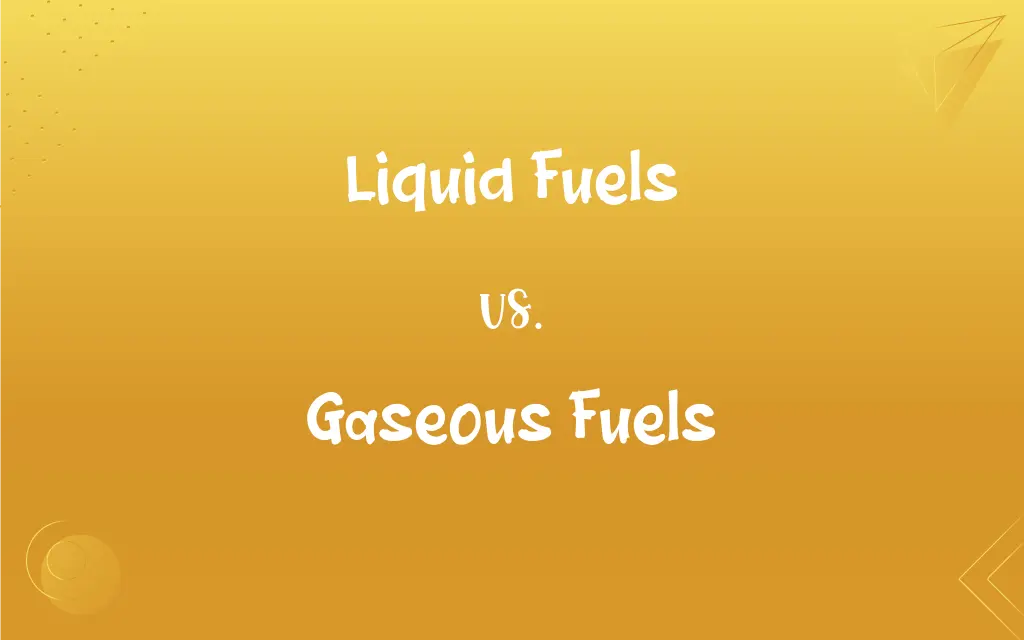Liquid Fuels vs. Gaseous Fuels: What's the Difference?
By Janet White & Harlon Moss || Published on March 28, 2024
Liquid fuels, like gasoline and diesel, are dense energy sources used widely in transportation. Gaseous fuels, such as natural gas and hydrogen, offer cleaner combustion but require more complex storage solutions.

Key Differences
Liquid fuels are characterized by their high energy density, making them particularly suitable for the transportation sector, where compact and efficient fuel storage is crucial. Gaseous fuels, while less dense in energy, burn more cleanly and efficiently, reducing emissions of pollutants and greenhouse gases.
The storage and transportation of liquid fuels are relatively straightforward, requiring sealed containers to prevent evaporation. In contrast, gaseous fuels need pressurized tanks or cryogenic storage to maintain them in a compact form, complicating logistics and increasing costs.
Liquid fuels have a well-established infrastructure globally, with extensive networks of refineries, pipelines, and fueling stations. Gaseous fuels are gaining infrastructure but still face limitations in distribution networks, which can hinder their accessibility and convenience.
From an environmental perspective, gaseous fuels generally offer advantages over liquid fuels, emitting fewer pollutants and contributing less to climate change when combusted. However, the production and distribution of gaseous fuels can still release methane, a potent greenhouse gas.
The choice between liquid and gaseous fuels often comes down to application-specific requirements, such as energy density for long-haul transportation versus emissions concerns for urban vehicles. Technological advances and policy developments continue to influence the competitive landscape between these fuel types.
ADVERTISEMENT
Comparison Chart
Energy Density
High
Lower than liquid fuels
Storage Requirements
Sealed containers to prevent evaporation
Pressurized or cryogenic storage needed
Transportation
Relatively easy, established infrastructure
Requires special handling and infrastructure
Environmental Impact
Higher emissions of CO2 and pollutants
Cleaner combustion, fewer pollutants
Infrastructure
Well-established globally
Developing, with some limitations
ADVERTISEMENT
Application Examples
Automobiles, aircraft, generators
Residential heating, power generation, some vehicles
Liquid Fuels and Gaseous Fuels Definitions
Liquid Fuels
Used widely in transportation.
Jet fuel, a liquid, powers commercial aircraft.
Gaseous Fuels
Fuels in gas form used for energy, such as natural gas.
Natural gas heats homes and powers some vehicles.
Liquid Fuels
Faces environmental scrutiny for emissions.
The combustion of liquid fuels in vehicles contributes to air pollution.
Gaseous Fuels
Growing infrastructure for distribution.
More cities are installing natural gas and hydrogen fueling stations.
Liquid Fuels
Characterized by high energy density.
Diesel fuel's high energy density makes it preferred for trucks.
Gaseous Fuels
Offers environmental benefits.
Biogas, a renewable gaseous fuel, reduces dependence on fossil fuels.
Liquid Fuels
Fuels in liquid form used for energy, such as gasoline.
Gasoline is a liquid fuel powering most cars.
Gaseous Fuels
Requires pressurized storage tanks.
Compressed natural gas (CNG) is stored under high pressure.
Liquid Fuels
Requires simple storage solutions.
Liquid fuels are stored in tanks at gas stations.
Gaseous Fuels
Burns cleaner than liquid fuels.
Hydrogen fuel emits only water vapor when used in fuel cells.
FAQs
What makes gaseous fuels environmentally friendly?
Gaseous fuels burn more cleanly than liquid fuels, producing fewer pollutants and greenhouse gases, thus offering environmental benefits.
Why are liquid fuels more commonly used in transportation?
Their high energy density and easy storage make liquid fuels more suitable for the compact and efficient fuel systems required in transportation.
How is natural gas stored and transported?
Natural gas can be compressed (as CNG) or liquefied (as LNG) for storage and transport, requiring pressurized tanks or cryogenic containers.
What are gaseous fuels?
Gaseous fuels are combustible gases used as a source of energy, known for their clean-burning properties and used in various applications from heating to power generation and transportation.
What are the challenges with using hydrogen as a fuel?
Challenges include storage and transport due to its low density, the need for high-pressure tanks, and the current lack of widespread infrastructure for fueling.
How do liquid and gaseous fuels impact engine design?
Engines designed for liquid fuels differ in fuel injection and combustion chamber design compared to those for gaseous fuels, which may require specialized fuel injectors and ignition systems to accommodate the different physical and combustion properties.
Can gaseous fuels be used in all types of vehicles?
While not all vehicles are currently equipped to use gaseous fuels, there is a growing number of natural gas and hydrogen fuel cell vehicles, particularly for buses, trucks, and some passenger cars.
What are liquid fuels?
Liquid fuels are combustible or energy-generating substances in liquid form, commonly used in vehicles, heating, and power generation.
What advancements are being made in gaseous fuel technologies?
Innovations include improved storage solutions, more efficient fuel cells for hydrogen, and enhanced distribution networks to make gaseous fuels more accessible and practical for a wider range of applications.
How do liquid and gaseous fuels compare in terms of cost?
The cost can vary depending on the region and market dynamics. Generally, gaseous fuels can be cheaper per unit of energy but may incur higher costs for storage and infrastructure.
What role do policies play in the adoption of gaseous fuels?
Government policies, including subsidies, tax incentives, and environmental regulations, play a significant role in promoting the use and development of cleaner gaseous fuels to mitigate climate change and reduce air pollution.
What are synthetic fuels, and how do they relate to liquid and gaseous fuels?
Synthetic fuels are created through chemical processes from carbon dioxide and water or biomass, potentially offering cleaner alternatives to conventional liquid and gaseous fuels while utilizing existing fuel infrastructure.
What is the role of liquid and gaseous fuels in renewable energy?
While traditionally associated with fossil fuels, both liquid and gaseous forms can be produced from renewable sources, such as biofuels and biogas, playing a crucial role in transitioning to sustainable energy systems.
How do safety considerations differ between liquid and gaseous fuels?
Safety concerns for liquid fuels include spill and fire hazards, while gaseous fuels pose risks related to pressure and potential leaks, requiring different safety protocols and equipment.
What are the implications of fuel choice on global energy security?
Diversifying energy sources by incorporating both liquid and gaseous fuels, including their renewable forms, can enhance energy security by reducing dependency on imported fuels and mitigating the impact of price volatility.
How do liquid and gaseous fuels compare in terms of energy transition?
Gaseous fuels, particularly those from renewable sources, are viewed as a critical component of the energy transition towards cleaner energy systems, complementing liquid biofuels and electrification in reducing carbon footprints.
How does the combustion temperature compare between liquid and gaseous fuels?
Gaseous fuels typically combust at higher temperatures than liquid fuels, influencing the design and materials used in combustion systems and engines to optimize efficiency and reduce emissions.
What future technologies could impact the use of liquid and gaseous fuels?
Advances in carbon capture and storage, fuel cell technology, and the development of green hydrogen and synthetic fuels could significantly impact the role and sustainability of both liquid and gaseous fuels in the global energy mix.
What are the economic impacts of shifting from liquid to gaseous fuels?
The shift can involve significant upfront costs for new infrastructure and technology development but may offer long-term economic benefits through reduced operating costs and environmental impact fees, in addition to creating new markets and job opportunities.
How does the volatility of fuel prices affect the adoption of liquid and gaseous fuels?
Price volatility can influence the adoption rates of alternative fuels; stable or lower prices for gaseous fuels can accelerate their adoption, while high or unpredictable prices for liquid fuels can drive the search for more economical and sustainable alternatives.
About Author
Written by
Janet WhiteJanet White has been an esteemed writer and blogger for Difference Wiki. Holding a Master's degree in Science and Medical Journalism from the prestigious Boston University, she has consistently demonstrated her expertise and passion for her field. When she's not immersed in her work, Janet relishes her time exercising, delving into a good book, and cherishing moments with friends and family.
Co-written by
Harlon MossHarlon is a seasoned quality moderator and accomplished content writer for Difference Wiki. An alumnus of the prestigious University of California, he earned his degree in Computer Science. Leveraging his academic background, Harlon brings a meticulous and informed perspective to his work, ensuring content accuracy and excellence.






























































